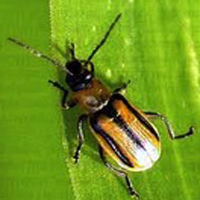Genetic and phenotypic effects of hybridization in independently introduced populations of the invasive maize pest Diabrotica virgifera virgifera in Europe

Accepted: 2 February 2021
HTML: 8
All claims expressed in this article are solely those of the authors and do not necessarily represent those of their affiliated organizations, or those of the publisher, the editors and the reviewers. Any product that may be evaluated in this article or claim that may be made by its manufacturer is not guaranteed or endorsed by the publisher.
Authors
The North American western corn rootworm, Diabrotica virgifera virgifera LeConte (Coleoptera: Chrysomelidae) was introduced into Europe several times during the end of the 20th century. Outbreaks in north-western Italy (NW Italian) and central and south-eastern Europe (CSE European) have merged in 2008 and insects interbreed since then. This study compared the genetic diversity (multi-locus genotype analyses at 13 microsatellites markers) and ten phenotypic traits among the CSE European and NW Italian populations as well as their hybrid offspring. All insects were reared under standardised laboratory conditions. Neutral genetic polymorphism appeared moderate in parental and hybrid populations, compared to North American populations. Some increase in neutral genetic variability was detected in the hybrids` expected heterozygosity and allelic richness compared to parental populations when family structures were considered. In 70% of the assessed phenotypic traits, the population type (CSE European, NW Italian, hybrids) influenced a trait, but averages in hybrids never exceeded those in their parents. Population type did not influence fecundity or adult lifespan (reflecting fitness) and not the proportion of adults flying (reflecting dispersal capabilities). There was no evidence yet that hybridization influences variability of phenotypic traits. In conclusion, there are only few indications that hybrids between the two overlapping invading European populations may in the longer term, take advantage through higher neutral genetic diversity and subsequent phenotypic adaptability.
Supporting Agencies
This research was funded by the French “l'Agence Nationale de la Recherche” (ANR-06-BDIV-008). Gerald Bermond was funded through a phd grant from the French Ministry of Research via the Doctoral School of Life Science of the University of Nice-Sophia Antipolis. CABI is an international intergovernmental organization and gratefully acknowledges the core financial support from its member countries (and lead agencies) including the United Kingdom (DFID), China (Chinese Ministry of Agriculture and Rural Affairs), Australia Australian Centre for International Agricultural Research), Canada (Agriculture and Agri-Food Canada), Netherlands (DGIS), and Switzerland (SDC). See https://www.cabi.org/about-cabi/who-wework- with/key-donors/for full detailsHow to Cite
PAGEPress has chosen to apply the Creative Commons Attribution NonCommercial 4.0 International License (CC BY-NC 4.0) to all manuscripts to be published.

 https://doi.org/10.4081/jear.2021.9559
https://doi.org/10.4081/jear.2021.9559



